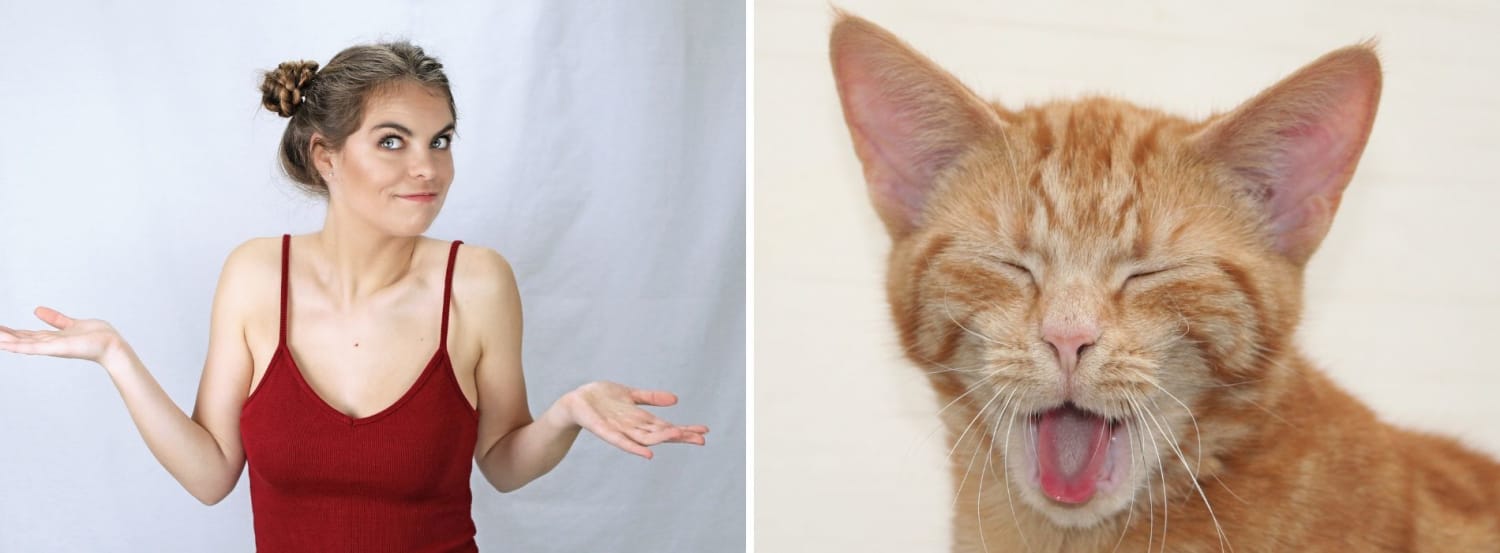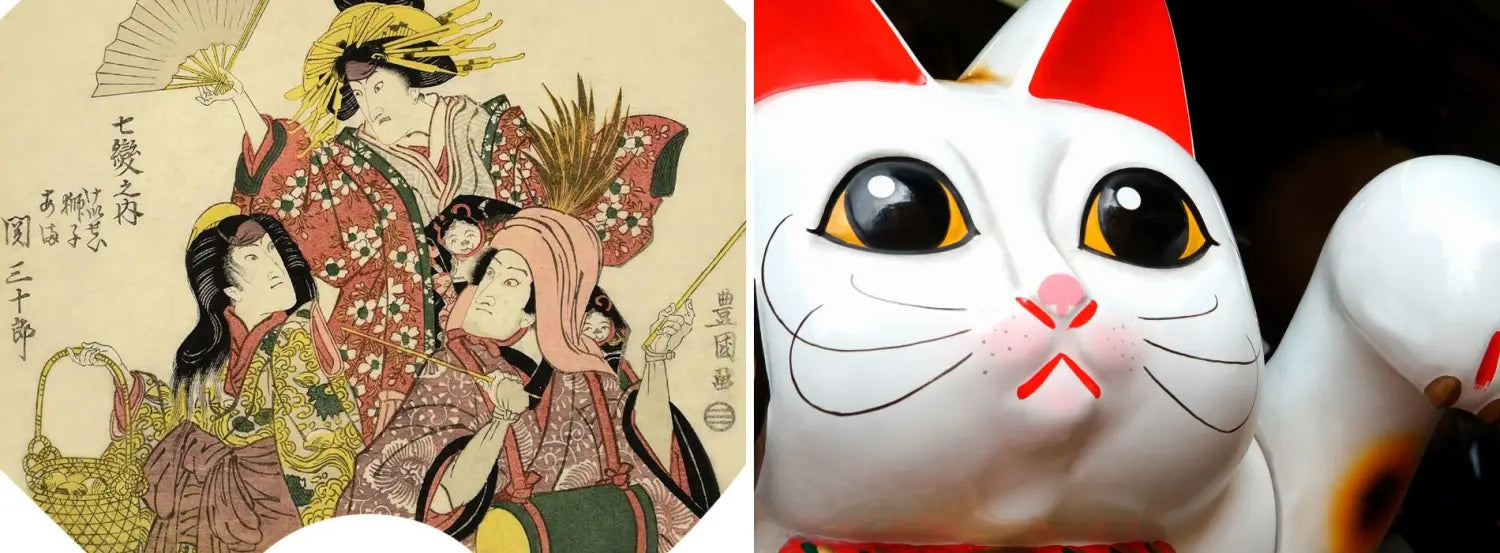What is "Maneki Neko"? The Japanese Lucky Cat

If you have the chance to visit Japan, you will probably have many opportunities to see small cat statuettes with the paw raised placed at the entrance of shops, restaurants and sometimes even in the homes of locals. This cat is called maneki neko in Japanese. But then... kesako?
What is maneki neko?

First of all, "maneki neko" in Japanese (招 き 猫) literally means "the cat that welcomes" or "the cat that invites". It is a traditional Japanese lucky charm depicted as a cat sitting, smiling and raising one or two front paws. This lucky cat is celebrated on September 29 in Japan and its interesting history goes back a long way.
Why a cat and where does it come from?

Legends related to the maneki neko
The history of the maneki neko is quite unclear. There are actually several legends that tell the story of this cat but the most popular one is the one about a rich lord named Naotaka Ii.
The temple cat and the lord Naotaka Ii
During the Edo period (1603-1867), west of Tokyo, there was a temple in a pitiful state. It was run by a very poor priest whose only companion was a cat named Tama with whom he shared his meager resources. One day, the rich lord Naotaka Ii passed by this temple on his way back from hunting when a violent storm broke out in the sky. He took refuge under a tree, just in front of the temple square where the cat Tama was standing. The cat was grooming itself, licking its paws and passing them behind its ears. The lord was intrigued by this cat and, thinking that the animal was beckoning him to come, left his shelter to approach it. A few seconds later, lightning struck the tree under which he had taken shelter earlier.

Without this cat that seemed to invite him with its raised paw, the lord Naotaka Ii would not be of this world anymore. He met the poor priest and saw the dilapidated state of the temple. As a sign of gratitude, the lord offered the priest enough money to restore the temple and live a comfortable life. After the cat's death, a statue was built of him sitting with his paw raised in memory of that stormy day. In the region, everyone considered that this cat had brought fortune and happiness to its owner, so the statue of the cat was copied and placed in houses and at the entrance of businesses. The maneki neko was born.
The temple about which the legend speaks would be the Gotokuji temple located in the Setagaya district, west of Tokyo. You can find there an altar covered with many maneki neko statues, placed by those who hope to attract luck and good fortune.
The courtesan
Another legend tells the story of a courtesan named Usugumo who lived with her cat in Yoshiwara, east of Tokyo. One night, her cat grabbed her kimono and started to pull on it wildly.
The courtesan tried to stop him, but nothing could be done, and the cat continued to damage her beautiful kimono by pulling on it. She decided to call for help and the owner of the brothel came running with his sword in hand.

Believing that the cat was possessed, he cut off its head with one blow. The cat's head flew into the air and with a last breath bit and killed a snake that was about to attack the courtesan.
After realizing that her cat was trying to protect her from the snake, Usugumo was devastated by the death of her faithful four-legged friend. To console her, a client carved a small wooden statue of her cat, one paw raised as if to warn of danger. This is how the tradition of maneki neko was born.
The old woman
In this legend, a poor old woman was forced to sell her cat to survive. Soon after, her cat appeared to her in a dream and told her to create a clay statue of him. As soon as she woke up, she obeyed, made a small statue of her cat and managed to sell it.

She made others and many people came to buy her statues which became popular. Thus, the poor woman became rich thanks to her cat. And, for the third time in this article, the tradition of maneki neko was born.
The Japanese cat that brings luck, love and fortune
Traditionally found at the entrance of businesses or placed prominently in Japanese homes, this cat statuette is reputed to be a powerful good luck charm that attracts good fortune, luck and prosperity to anyone who owns one.

The power of this Japanese cat will depend on the raised paw, its color and the symbols drawn on its belly. This is what we will see...
The gesture of the cat who invites
Why does the maneki neko mean "the cat that invites"? And why does this cat have a paw raised near its ear?
It may seem strange to us Westerners, but this gesture is very similar to the Japanese way of waving to come. Indeed, the people of Japan (and China) invite people to come by raising the hand palm outwards and lowering the arm and fingers forward several times. In the most common legend of maneki neko, Lord Naotaka Ii confuses this gesture with the movement that a cat makes when it cleans behind its ears with its paw.
Since this lucky cat has crossed borders to the West, there are some versions that have the palm turned backwards to recall the Western gesture of invitation.
Maneki neko can raise the right paw, the left paw or sometimes both at the same time. If the cat raises its left paw then it will attract customers, while if it raises its right paw it will attract fortune and luck. Or the opposite. Indeed, the meaning of the raised paw can be different according to the time and the regions; and the beliefs on this subject are various and varied.

Anyway, Japanese people seem to agree that the higher the paw of the cat, the more luck it attracts (or the more luck comes from far away). Over time, the paws of the maneki neko have become higher and higher, it is even possible to determine its era according to this height.
Some more modern versions of the maneki neko have a raised paw that swings back and forth thanks to a battery or a solar sensor. This solar maneki neko will then repeat its welcoming gesture endlessly.
The color variations of the lucky Japanese cat
Depending on the color of the statuette, the maneki neko will not necessarily have the same meaning.
Get A Tricolor Maneki Neko
Tricolor: this is the most popular version of this cat, it is white with black and red spots. The color of this coat is very rare in Japanese bobtails, the breed of cat that served as a model for the maneki neko. In Japan, this "triple coat" is called mi-ke.
White Maneki Neko
White: this is the second most popular version. White is a symbol of purity and happiness in Japan.
Black Maneki Neko
Black: This color is believed to ward off evil spirits. Black cats are popular with women because they are known to keep attackers at bay.
Red Maneki Neko
Red : it is a protective color associated with health, it is supposed to repel evil spirits and diseases.
Maneki Neko Gold
Golden: This color is associated with wealth and attracts financial fortune.
Green Maneki Neko

Green: the green maneki neko is associated with school and university success.
Pink Maneki Neko

Pink: far from being traditional, this color has become popular and is associated with love.
The different attributes of Maneki neko
This emblematic cat is often represented with symbols drawn on its belly or objects between its paws. Most often, the maneki neko wears a red collar with a small bell and a decorative bib around its neck. These attributes represent the accessories that were worn by the cats of rich owners in the Edo period.

Sometimes the maneki neko holds a big gold coin against its belly, called Koban. This gold coin was used during the Edo era in Japan and was worth one Ryo, the common currency at that time (now replaced by the Yen). Most of the Koban worn by maneki neko are marked with an inscription that specifies that this coin is worth ten million Ryo. Needless to say that this attribute symbolizes wealth and helps the cat to attract luck and fortune to its owner. Moreover, it is not uncommon to see Japanese people putting a coin on the statuette, just as a Westerner would throw a coin in a well or a fountain.
Where to buy a Maneki neko?
Who would say no to a little happiness, fortune and wealth? Especially when the lucky charm looks like a cat as cute as the maneki neko.
Take a look at our collection of Maneki Neko, you will find many maneki neko in different forms. This emblematic cat has been for a long time declined in different products.
Wish your friends happiness and luck by offering them this Japanese lucky charm and attract good fortune and prosperity in your home!












































































